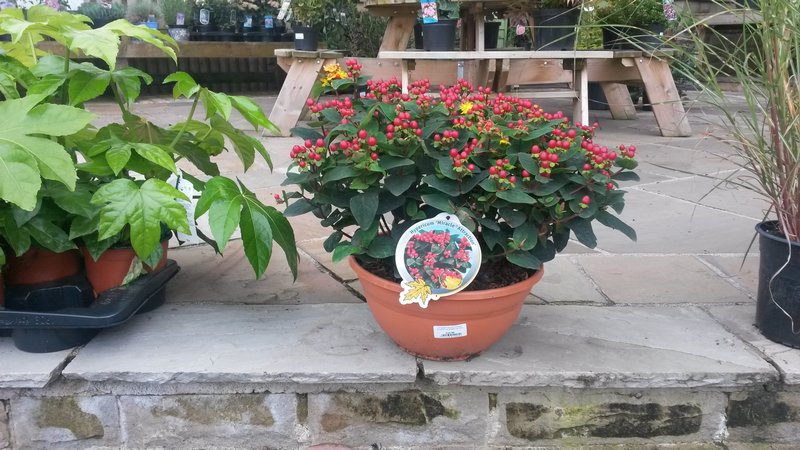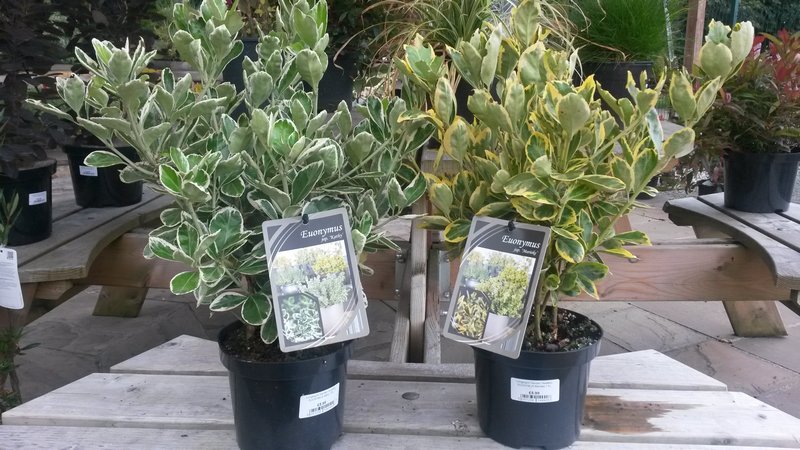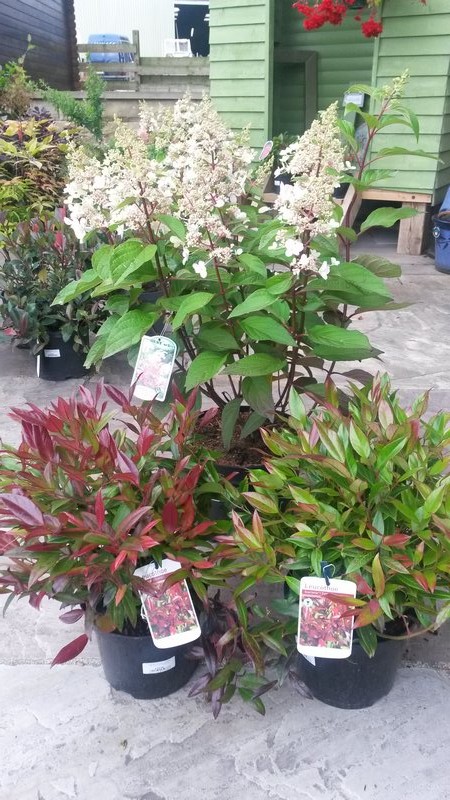September Plants at Longsight NurseryA selection of Salvia and Hibiscus in 3ltr pots. Salvia Salvias are a large group of garden plants that includes annuals, biennials, perennials, and shrubs. The perennial salvias are mainstays of the midsummer garden border. Another common name is sage.About This PlantA relative of the familiar kitchen sage, flowering salvias produce spikes of small, densely packed flowers atop aromatic foliage. These heat- and drought-tolerant beauties bloom from early to late summer in shades of blue, violet, red, pink, and white. Plants grow 18 inches to 5 feet tall, depending on the variety. Use care when choosing salvias, because not all plants are hardy in all regions. Special Features
Site Selection Select a site with full sun and very well-drained soil. Planting Instructions Plant in spring, spacing plants 1 to 3 feet apart, depending on the variety. Prepare the garden bed by using a garden fork or tiller to loosen the soil to a depth of 12 to 15 inches, then mix in a 2- to 4-inch layer of compost. Dig a hole twice the diameter of the pot the plant is in. Carefully remove the plant from its container and place it in the hole so the top of the root ball is level with the soil surface. Carefully fill in around the root ball and firm the soil gently. Water thoroughly. Care Apply a thin layer of compost each spring, followed by a 2-inch layer of mulch to retain moisture and control weeds. Water plants during the summer if rainfall is less than 1 inch per week. Some types can be sheared back after flowering to induce a second flush of flowers in fall. After the first killing frost, cut stems back to an inch or two above soil line. Divide plants every 3 to 4 years as new growth begins in the spring, lifting plants and dividing them into clumps. http://www.garden.org/plantguide/?q=show&id=2058 Hypericum (St. John's Wort) By: Shila Patel In medieval times, people thought St. John's wort (Hypericum perforatum) protected them from demonic possession. Maybe they were right. Today, it is widely used to treat mild depression, anxiety, and insomnia, and its antiviral properties are under investigation. It's now so popular that various formulations are widely marketed, but one of the simplest ways to realize its therapeutic benefits is still the old-fashioned way, as an infusion. Since this herbaceous perennial was brought to New England by European settlers, it has naturalized across much of the continent. It thrives throughout USDA Hardiness Zones 4 through 8 but also grows in zones 3 and 9. In California, Idaho, Montana, and Oregon, St. John's wort grows too well so is considered a noxious weed, and gardeners there cannot buy plants or seeds. In many other regions it is also abundant in woods, meadows, and along roadsides. And gathering from the wild is not considered harmful to the existing population. Before harvesting wild plants, make sure that they have not been treated with pesticides or other chemicals. The key medicinal constituents are concentrated in the buds, flowers, and upper leaves. A combination of genetic and environmental factors governs their concentration. For instance, narrow-leaved varieties seem to have higher concentrations of hypericin, a key compound, than broad-leaved kinds. But in every case, the level of active chemicals drops dramatically after flowers are pollinated. Harvest and Making TeaHarvest plants while they're in early bloom, after a minimum of four flowers have opened. Snip off the top 8 inches of the shoots, including a mix of unopened buds, flowers, and leaves. Protect them from light, and dry them rapidly to preserve volatile compounds. Dry them for about 10 hours in a warm (86° F to 104° F) dark area. Store completely dried herbs in a cool (less than 68° F), dry, dark place for up to a year. To make an infusion, steep about 2 teaspoons of the dried herb in 5 ounces of boiling water for 10 minutes. Drink it twice a day with food; its effects are not immediate -- they may take several months. Some people experience increased sensitivity to sunlight while taking the herb. Before using any botanical as part of a healthcare program, consult a qualified health practitioner. Seeds and plants are widely available. Escallonia 'Red Dream' (Escallonia 'Red Dream') will reach a height of 0.6m and a spread of 1m after 10-20 years. Suggested uses: Beds and borders, Coastal, Hedging/Screens, Low Maintenance Cultivation: Plant in well-drained soil in full sun, sheltered from cold winds. Soil type: Chalky, Clay, Loamy, Sandy (will tolerate most soil types) Soil drainage: Moist but well-drained, Well-drained Soil pH: Acid, Alkaline, Neutral Light: Full Sun Aspect: North, South, East, West Exposure: Sheltered Hardiness: Hardy (H4) Spirea By: National Gardening Association Editors Spireas are small to medium sized deciduous shrubs that produce cascades of flowers in spring and summer. About This Plant Among the easiest flowering shrubs to grow, spireas are often used in foundation plantings, as hedges, and in perennial gardens. Most spireas bloom in late spring to midsummer. Flower colors include pink, red, yellow, and white, depending on the variety. Some types have colorful fall foliage. Size depends on the species and variety, and can range from 2 to 10 feet tall and wide. Low-growing bumald spirea (S. bumalda) and medium-sized Japanese spirea (S. japonica) can be used throughout the landscape. Vanhoutte spirea (S. vanhouttei), the classic bridal wreath spirea, grows up to 10 feet tall and 20 feet wide, so give it plenty of elbow room. Masses of small, white flower clusters cover the plant in the spring. Special Features
Space plants 2 to 15 feet apart, depending on the expected mature size of the plant. Dig a hole only as deep as the root ball and 2 to 3 times as wide. If your soil is in very poor condition, amend the soil you've removed from the hole with a small amount of compost. Otherwise don't amend it at all. Carefully remove the plant from the container and set it in the hole. Fill in around the root ball with soil until the hole is about half filled. Then firm the soil and water thoroughly. Fill the hole with the remaining soil and water again. Form a raised ridge of soil around the perimeter of the hole so it acts like a berm to help hold in water. Care Apply a layer of compost under the tree each spring, spreading it out to the dripline (the area under the outermost branches). Add a 2-inch layer of mulch to retain moisture and control weeds. Water plants during the summer if rainfall is less than 1 inch per week. Deadheading spent flowers will sometimes induce a second flowering. Most spireas can be pruned after flowering to reduce height and maintain the desired shape. However, Japanese and bumald spireas should be pruned in early spring to promote the best flowering. Remove dead, diseased, and broken branches anytime. Spireas can be severely pruned and will grow and flower again. http://www.garden.org/articles/articles.php?q=show&id=2103 Sedum By: National Gardening Association Editors The succulent foliage of many types of sedum is topped by starry flowers in late summer and fall. Low-growing types are perfect for rock gardens, while taller varieties thrive in perennial borders. Another common name is stonecrop. About This Plant There are numerous types of sedum, all of which have fleshy, succulent leaves. Low-growing varieties hug the ground and may reach just 2 inches in height, while tall varieties top out at 2 feet or more. Use the low-growing types as ground covers and in rock gardens; tall varieties command attention in the perennial border with their dense foliage and large flower heads. Flower colors include red, pink, gold, yellow, and white, and plants bloom in summer to fall, depending on the species. Well-drained soil is essential to ward off fungal diseases, especially during wet summers. Special Features
Site Selection Select a site with full sun to light shade and very well-drained soil. Planting Instructions Plant in spring, spacing plants 6 inches to 2 feet apart, depending on the variety. Prepare the garden bed by using a garden fork or tiller to loosen the soil to a depth of 12 to 15 inches, then mix in a 2- to 4-inch layer of compost. Dig a hole twice the diameter of the pot the plant is in. Carefully remove the plant from its container and place it in the hole so the top of the root ball is level with the soil surface. Carefully fill in around the root ball and firm the soil gently. Water thoroughly. Care Apply a thin layer of compost each spring, followed by a 2-inch layer of mulch to retain moisture and control weeds. Water plants during the summer if rainfall is less than 1 inch per week. After the first killing frost, cut stems back to an inch or two above soil line. Divide plants every 3 to 4 years as new growth begins in the spring, lifting plants and dividing them into clumps. http://www.garden.org/articles/articles.php?q=show&id=2059 Andromeda (Bog Rosemary) Bog-rosemary is native to cold northern bogs in North America, Europe, and Asia. It grows to a height of about 1 foot with oblong or lance-shaped leaves up to 1 1/2 inches long with rolled-under margins. The plant flowers in late spring or early summer, with numerous 1/4" flowers. The plant tolerates extreme cold, but suffers in areas with hot summers. Their soil should be acid and stay somewhat moist at all times. Light shade is best. Established plants should be mulched with peat moss or sphagnum moss for best results. (This plant should not be confused with what are commonly called garden andromedas, which belong to the genus Pieris and others.) Festuca Festuca glauca \'Elijah Blue\' is winter hardy to zone 4, grows in full sunshine, adapts to any soil type and is reliable in your gardening region. It grows 8-12 inches tall and wide. Lavandula Lavender will flourish in most well drained garden soils, being especially suited to chalky soils. Plant in full sun in sheltered areas - preferably south facing. Trim flower shoots after flowering, prune last years growth to shape in spring. Lonicera Lonicera (honeysuckle) are popular garden plants with highly perfumed flowers. There are climbing honeysuckles, which are wonderful draped over pergolas and supports, and evergreen shrubby types, which make good hedging plants. Flowering time Climbers flower in summer; shrubs in late winter, spring or summer. Planting time- Deciduous in winter; evergreens in spring or autumn Height and spread Various. Aspect- Full sun or partial shade. Hardiness- Mostly fully hardy, some tender species e.g. L. hildebrandiana. Difficulty- Easy. Cotinus Cogg (Smoketree / Smokebush) Cotinus coggygria By: Paul Simon The Smoke Tree is most widely known for its large billowing summer blooms that have a puffy cloud-like or "smoky" appearance. The large blooms provide an attractive characteristic as they wisp in the air with a gentle summer breeze. About This Plant The smoketree is most widely used as a specimen tree, with its attractive "smoke-like" inflorescences appearing in early to late summer. As clusters of tiny blooms fade away in the late spring, this plant shoots out hairy-like filaments, producing an attractive "smoky" billowing plume. Selections include varieties with green or purple foliage, changing to shades of orange, red, or purple in autumn. It has a rounded form, growing approximately 10 to 12 feet high and wide, but sometimes as tall as 20 feet. It is hardy in Zones 5-9. Site Selection The smoketree is very easy to grow and drought resistant as well. It prefers well drained or dry soil conditions and full sun but can also tolerate partial shade conditions. A single tree can act as a focal point or feature in the garden; when planted in groups of three or more, smoketrees can make a very vibrant display as a hedge or colorful backdrop for your other garden plantings. Planting Instructions Be sure to dig your hole at least twice as wide as the container size and mix in a shovelful of compost when planting. When setting your plant, be sure that the top of the root ball is slightly higher than the grade surrounding the perimeter of the dug hole. Fill the remainder of the hole with well drained soil and water. Care Once established, a heavy spring pruning can help force the most colorful new growth for a display of color and multiple shoots. Keep in mind that dry summer conditions promote a very showy and vibrant fall color to your smoketree. `Royal Purple´ variety is well known for its deep purple foliage and red-purple autumn fall color. The new growth of `Golden Spirit´ emerges bright gold, changing to lime green in summer and shades of orange and red in fall. Pieris Pieris are compact evergreen shrubs with leathery, dark green leaves, often brightly coloured when young, and small white urn-shaped flowers borne in panicles in spring. 'Mountain Fire' is a bushy medium-sized evergreen shrub with red young leaves, turning coppery-green and finally dark green; flowers creamy-white, in branched panicles in mid spring.
Continus Cogg (See above for details) Skimmia are compact evergreen shrubs with simple, aromatic leaves and terminal panicles of small white or yellowish flowers followed, on fertilised female plants, by shiny red berries; most have male and female flowers on separate plants. 'Rubella' is a small, bushy evergreen shrub with dark green, elliptic leaves to 10cm long. Panicles of red buds, showy in late winter, open to fragrant white flowers in early spring. Hydrangea
Pinky-Winky is one of the best suited to small gardens. Blooming from early August to early October, the flowers open in lime green and develop yellow tints as they age. They mature to deepest pink often revealing all the colours in one spike – the effect enhanced by red stems. The flowers also have a spicy fragrance. Flowering time can easily be controlled by hard pruning (late flowers) or dead-heading only (early flowers). 1.4m (4ft 6in). Leucothoe
1 Comment
Nausheen
1/8/2024 07:38:57
Your explanations are easy to follow, making it accessible for beginners. If you're interested in more information, <a href="https://medicinalseedkit.com/kit/#aff=Aeinaa" target="_blank">click here</a>.
Reply
Leave a Reply. |
AuthorThis website and blog has been produced to showcase the fantastic work this team undertakes every week. You only have to scroll through the pages to see the quality of work undertaken. It is a pleasure to highlight this and hopefully inspire others to seek new ideas for further projects. Archives
July 2024
Categories
All
|
Contact Sales: 01254 247075Website LinksSheds | Log Cabins | Bike Store | Garden Buildings | Fencing | Paving | Plants & Flowers |
Log Cabin | Bespoke Garden Buildings | Log Huts | Kiln Dried Hardwood Logs | Plant Wholesale | FIREWOOD | Composite Decking | Garden Rooms | Greenhouses | BBQ Shed Huts | Summerhouses | Fence Panels | BBQ Huts | Barrels | Grill Cabin | Sheds | Log Stores | Camping Pods | Fencing Supplies | Garden Office | Logs | Plant Wholesale | KILN DRIED LOGS | Delivery | Terms & Conditions | Privacy Policy | Copyright Longsight Nursery Ltd 2012 - 2024. All Rights Reserved. |
|











 RSS Feed
RSS Feed



